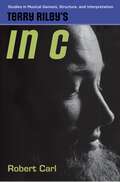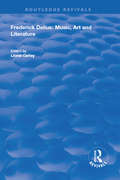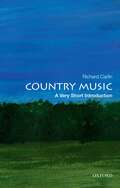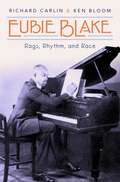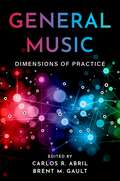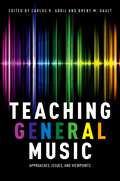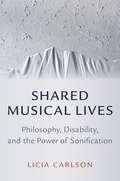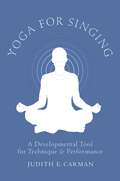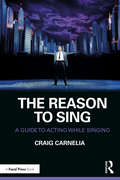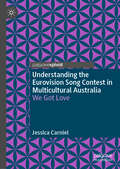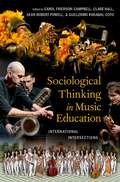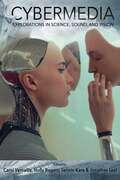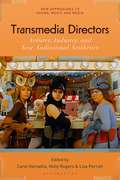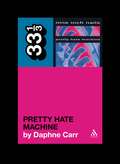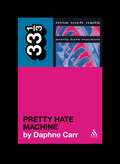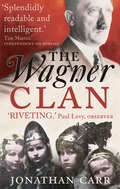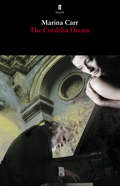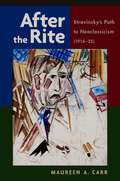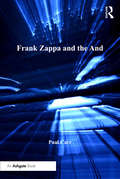- Table View
- List View
Terry Riley's In C (Studies in Musical Genesis, Structure, and Interpretation)
by Robert CarlSetting the stage for a most intriguing journey into the world of minimalism, Robert Carl's Terry Riley's In C argues that the work holds its place in the canon because of the very challenges it presents to "classical" music. Carl examines In C in the context of its era, its grounding in aesthetic practices and assumptions, its process of composition, presentation, recording, and dissemination.
Frederick Delius: Music, Art and Literature (Routledge Revivals)
by Lionel CarleyFirst published in 1998, Carley collates twelve essays by an international group of contributors reflects the truly cosmopolitan nature of Delius’s life and his music. They reveal the manner in which he absorbed the culture of the nations he came to know, their music, art and literature, and the influences they brought to bare on his own work. Also discussed are some of the often mixed, but rarely equivocal reactions that performances of his music have reactions over the years, with Lionel Carley’s in-depth study of the first production of Foleraadet in 1897, and a wide ranging analysis by Don Gillespie and Robert Beckhard of the critical reception of Delius’s music in the United States between 1909 and 1920.
Frederick Delius: Music, Art and Literature (Routledge Revivals)
by Lionel CarleyFirst published in 1998, Carley collates twelve essays by an international group of contributors reflects the truly cosmopolitan nature of Delius’s life and his music. They reveal the manner in which he absorbed the culture of the nations he came to know, their music, art and literature, and the influences they brought to bare on his own work. Also discussed are some of the often mixed, but rarely equivocal reactions that performances of his music have reactions over the years, with Lionel Carley’s in-depth study of the first production of Foleraadet in 1897, and a wide ranging analysis by Don Gillespie and Robert Beckhard of the critical reception of Delius’s music in the United States between 1909 and 1920.
Country Music: A Biographical Dictionary (Very Short Introductions)
by Richard CarlinCountry Music: A Very Short Introduction presents a compelling overview of the music and its impact on American culture. Country music has long been a marker of American identity; from our popular culture to our politics, it has provided a soundtrack to our national life. While traditionally associated with the working class, country's appeal is far broader than any other popular music style. While this music rose from the people, it is also a product of the popular music industry, and the way the music has been marketed to its audience is a key part of its story. Key artists, songs, and musical styles are highlighted that are either touchstones for a particular social event (such as Tammy Wynette's "Stand By Your Man," which produced both a positive and negative backlash as a marker of women's roles in society at the beginning of the liberation movement) or that encompass broader trends in the industry (for example, Jimmie Rodgers' "T for Texas" was an early example of the appropriation of black musical forms by white artists to market them to a mainstream audience). While pursuing a basically chronological outline, the book is structured around certain recurring themes (such as rural vs. urban; tradition vs. innovation; male vs. female; white vs. black) that have been documented through the work of country artists from the minstrel era to today. Truly the voice of the people, country music expresses both deep patriotism as well as a healthy skepticism towards the powers that dominate American society. Country Music: A Very Short Introduction illuminates this rich tradition and assesses its legacy in American popular music culture.
Country Music: A Very Short Introduction (Very Short Introductions)
by Richard CarlinCountry Music: A Very Short Introduction presents a compelling overview of the music and its impact on American culture. Country music has long been a marker of American identity; from our popular culture to our politics, it has provided a soundtrack to our national life. While traditionally associated with the working class, country's appeal is far broader than any other popular music style. While this music rose from the people, it is also a product of the popular music industry, and the way the music has been marketed to its audience is a key part of its story. Key artists, songs, and musical styles are highlighted that are either touchstones for a particular social event (such as Tammy Wynette's "Stand By Your Man," which produced both a positive and negative backlash as a marker of women's roles in society at the beginning of the liberation movement) or that encompass broader trends in the industry (for example, Jimmie Rodgers' "T for Texas" was an early example of the appropriation of black musical forms by white artists to market them to a mainstream audience). While pursuing a basically chronological outline, the book is structured around certain recurring themes (such as rural vs. urban; tradition vs. innovation; male vs. female; white vs. black) that have been documented through the work of country artists from the minstrel era to today. Truly the voice of the people, country music expresses both deep patriotism as well as a healthy skepticism towards the powers that dominate American society. Country Music: A Very Short Introduction illuminates this rich tradition and assesses its legacy in American popular music culture.
Eubie Blake: Rags, Rhythm, and Race
by Richard Carlin Ken BloomA new biography of one of the key composers of 20th-century American popular song and jazz, Eubie Blake: Rags, Rhythm and Race illuminates Blake's little-known impact on over 100 years of American culture. A gifted musician, Blake rose from performing in dance halls and bordellos of his native Baltimore to the heights of Broadway. In 1921, together with performer and lyricist Noble Sissle, Blake created Shuffle Along which became a sleeper smash on Broadway eventually becoming one of the top ten musical shows of the 1920s. Despite many obstacles Shuffle Along integrated Broadway and the road and introduced such stars as Josephine Baker, Lottie Gee, Florence Mills, and Fredi Washington. It also proved that black shows were viable on Broadway and subsequent productions gave a voice to great songwriters, performers, and spoke to a previously disenfranchised black audience. As successful as Shuffle Along was, racism and bad luck hampered Blake's career. Remarkably, the third act of Blake's life found him heralded in his 90s at major jazz festivals, in Broadway shows, and on television and recordings. Tracing not only Blake's extraordinary life and accomplishments, Broadway and popular music authorities Richard Carlin and Ken Bloom examine the professional and societal barriers confronted by black artists from the turn of the century through the 1980s. Drawing from a wealth of personal archives and interviews with Blake, his friends, and other scholars, Eubie Blake: Rags, Rhythm and Race offers an incisive portrait of the man and the musical world he inhabited.
General Music: Dimensions of Practice
by Carlos R. Abril and Brent M. GaultGeneral Music: Dimensions of Practice is a practical guide for music teachers and teaching artists who strive to teach music holistically. The book begins by framing general music as a holistic music education that is comprehensive, meaningful, and relevant to diverse learners in school and community settings. It is followed by chapters that are organized into one of four dimensions of music practice: performing, connecting, creating, and responding. Chapter authors share creative and innovative teaching ideas, for both elementary and secondary school students, that focus on a wide range of topics, including: songwriting, composing, improvising, singing, moving, playing, listening, analyzing, contextualizing, and connecting. Each chapter provides (a) a rationale for a given area of music study, establishing its importance and relevance; (b) a research or theoretical background, to inform and guide practice; and (c) a pedagogical model or framework illustrated through lesson ideas, curriculum units, or vignettes. The ideas in this book seek to inspire and guide teachers as they build comprehensive music programs that are informed by students and communities.
TEACHING GENERAL MUSIC C: Approaches, Issues, and Viewpoints
by Carlos R. Abril and Brent M. GaultGeneral music is informed by a variety of teaching approaches and methods. These pedagogical frameworks guide teachers in planning and implementing instruction. Established approaches to teaching general music must be understood, critically examined, and possibly re-imagined for their potential in school and community music education programs. Teaching General Music brings together the top scholars and practitioners in general music education to create a panoramic view of general music pedagogy and to provide critical lenses through which to view these frameworks. The collection includes an examination of the most prevalent approaches to teaching general music, including Dalcroze, Informal Learning, Interdisciplinary, Kodály, Music Learning Theory, Orff Schulwerk, Social Constructivism, and World Music Pedagogy. In addition, it provides critical analyses of general music and teaching systems, in light of the ways children around the world experience music in their lives. Rather than promoting or advocating for any single approach to teaching music, this book presents the various approaches in conversation with one another. Highlighting the perceived and documented benefits, limits, challenges, and potentials of each, Teaching General Music offers myriad lenses through which to re-read, re-think, and re-practice these approaches.
Shared Musical Lives: Philosophy, Disability, and the Power of Sonification
by Licia CarlsonShared Musical Lives makes the case for the epistemological and ethical significance of musical experience. Music can be a source of self-knowledge and self-expression, and hence reveal important dimensions of the self to others. This knowledgeof both self and of othershas a moral force as well. Shared musical experience can transform and establish new modes of being with others, cultivate virtues, and expand the moral imagination. The term sonification (which means translating data into non-verbal audible tones) provides an organizing principle for the arguments in the book. Transposing the concept into a philosophical key, this book explores two forms of sonification: first, the process by which musical experience reveals dimensions of the self and relationships with others; and second, philosophical sonification, or the critical examination of philosophical concepts, arguments, and theories in view of what musical experience reveals. These two kinds of sonification are discussed specifically in the context of disability. In this book, author Licia Carlson brings the musical lives of people with cognitive and intellectual disabilities into the foreground in order to challenge and broaden existing conceptions of disability and music and provide new ways of thinking about the philosophies of music and disability.
Shared Musical Lives: Philosophy, Disability, and the Power of Sonification
by Licia CarlsonShared Musical Lives makes the case for the epistemological and ethical significance of musical experience. Music can be a source of self-knowledge and self-expression, and hence reveal important dimensions of the self to others. This knowledgeof both self and of othershas a moral force as well. Shared musical experience can transform and establish new modes of being with others, cultivate virtues, and expand the moral imagination. The term sonification (which means translating data into non-verbal audible tones) provides an organizing principle for the arguments in the book. Transposing the concept into a philosophical key, this book explores two forms of sonification: first, the process by which musical experience reveals dimensions of the self and relationships with others; and second, philosophical sonification, or the critical examination of philosophical concepts, arguments, and theories in view of what musical experience reveals. These two kinds of sonification are discussed specifically in the context of disability. In this book, author Licia Carlson brings the musical lives of people with cognitive and intellectual disabilities into the foreground in order to challenge and broaden existing conceptions of disability and music and provide new ways of thinking about the philosophies of music and disability.
Yoga for Singing: A Developmental Tool for Technique and Performance
by Judith E. CarmanThe 19th-century Italian singing teacher Giovanni Battista Lamperti once wrote, "'Know thyself' applies to the singer more than to other professions, because to sing well, body, soul, and mind are tuned together." Yoga, with its focus on connecting mind, body, and soul, is a tool that can greatly enhance the art of singing in this very way. In Yoga for Singing, author Judith Carman outlines the many connections between the two arts, presenting a systematic approach to yoga practices to support the development of singing technique as well as to lay a foundation for confident performance and a long and healthy singing career. She demonstrates how closely practices such as physical postures, breathing practices, and deep relaxation techniques match the needs of singers. Included in the book and its extensive companion website are copious illustrations and specific exercises designed to be used by singers and voice teachers, regardless of their level of experience with yoga. With a unique take on technique and performance improvement, this book is an excellent resource for both vocal students and professionals at any stage of their career.
Yoga for Singing: A Developmental Tool for Technique and Performance
by Judith E. CarmanThe 19th-century Italian singing teacher Giovanni Battista Lamperti once wrote, "'Know thyself' applies to the singer more than to other professions, because to sing well, body, soul, and mind are tuned together." Yoga, with its focus on connecting mind, body, and soul, is a tool that can greatly enhance the art of singing in this very way. In Yoga for Singing, author Judith Carman outlines the many connections between the two arts, presenting a systematic approach to yoga practices to support the development of singing technique as well as to lay a foundation for confident performance and a long and healthy singing career. She demonstrates how closely practices such as physical postures, breathing practices, and deep relaxation techniques match the needs of singers. Included in the book and its extensive companion website are copious illustrations and specific exercises designed to be used by singers and voice teachers, regardless of their level of experience with yoga. With a unique take on technique and performance improvement, this book is an excellent resource for both vocal students and professionals at any stage of their career.
The Reason to Sing: A Guide to Acting While Singing
by Craig CarneliaIn The Reason to Sing, renowned composer-lyricist and teacher Craig Carnelia provides musical actors with a step-by-step guide to making their singing performances more truthful, vivid, and full of life. Using a technique developed over decades of teaching the professional community of Broadway actors and students alike, The Reason to Sing utilizes detailed descriptions of sessions the author has had with his notable students and lays out a new and proven approach to help you build your skills, your confidence, and your career. This book is intended for musical theater acting students as well as working professionals and teachers of the craft.
The Reason to Sing: A Guide to Acting While Singing
by Craig CarneliaIn The Reason to Sing, renowned composer-lyricist and teacher Craig Carnelia provides musical actors with a step-by-step guide to making their singing performances more truthful, vivid, and full of life. Using a technique developed over decades of teaching the professional community of Broadway actors and students alike, The Reason to Sing utilizes detailed descriptions of sessions the author has had with his notable students and lays out a new and proven approach to help you build your skills, your confidence, and your career. This book is intended for musical theater acting students as well as working professionals and teachers of the craft.
Understanding the Eurovision Song Contest in Multicultural Australia: We Got Love
by Jessica CarnielThis book presents the first in-depth study of the Eurovision Song Contest from an Australian perspective. Using a cultural studies approach, the study draws together fan interviews and surveys with media and textual analysis of the contest itself. In doing so, it begins to answer the question of why the European song contest appeals to viewers in Australia. It explores and challenges the dominant narrative that links Eurovision fandom to post-WWII European migration, arguing that this Eurocentric narrative presents a limited view of how contemporary Australian multicultural society operates in the context of globalized culture. It concludes with a consideration of the future of the Eurovision Song Contest as Australia enters into the ‘Asian century’.
Sociological Thinking in Music Education: International Intersections
by Carol Frierson-Campbell, Clare Hall, Sean Robert Powell, Guillermo Rosabal-CotoSociological Thinking in Music Education presents new ideas about music teaching and learning as important social, political, economic, ecological, and cultural ways of being. At the book's heart is the intersection between theory and practice where readers gain glimpses of intriguing social phenomena as lived through music learning and teaching. The vital roles played by music and music education in various societies around the world are illustrated through pivotal intersections between music education and sociology: community, schooling, and issues of decolonization. In this book, emerging as well as established scholars mobilize the links between applied sociology, music, education, and music education in ways that intersect the scholarly and the personal. These interdisciplinary vantage points fulfil the book's overarching aim to move beyond mere descriptions of what is, by analyzing how social inequalities and inequities, conflict and control, and power can be understood in and through music teaching and learning at both individual and collective levels. The result is not only encountering new ideas regarding the social construction of music education practices in specific places, but also seeing and hearing familiar ones in fresh ways. Digital assets enable readers to meet the authors and the points of their inquiry via various audiovisual media, including videos, a documentary music film, and multi-lingual video précis for each chapter in English as well as in each author's language of origin.
Cybermedia: Explorations in Science, Sound, and Vision (New Approaches to Sound, Music, and Media)
by Carol Vernallis, Holly Rogers, Selmin Kara and Jonathan LealWe're experiencing a time when digital technologies and advances in artificial intelligence, robotics, and big data are redefining what it means to be human. How do these advancements affect contemporary media and music? This collection traces how media, with a focus on sound and image, engages with these new technologies. It bridges the gap between science and the humanities by pairing humanists' close readings of contemporary media with scientists' discussions of the science and math that inform them. This text includes contributions by established and emerging scholars performing across-the-aisle research on new technologies, exploring topics such as facial and gait recognition; EEG and audiovisual materials; surveillance; and sound and images in relation to questions of sexual identity, race, ethnicity, disability, and class and includes examples from a range of films and TV shows including Blade Runner, Black Mirror, Mr. Robot, Morgan, Ex Machina, and Westworld. Through a variety of critical, theoretical, proprioceptive, and speculative lenses, the collection facilitates interdisciplinary thinking and collaboration and provides readers with ways of responding to these new technologies.
Transmedia Directors: Artistry, Industry and New Audiovisual Aesthetics (New Approaches to Sound, Music, and Media)
by CarolHollyLisa Vernallis Rogers PerrottTransmedia Directors focuses on artist-practitioners who work across media, platforms and disciplines, including film, television, music video, commercials and the internet. Working in the age of media convergence, today's em/impresarios project a distinctive style that points toward a new contemporary aesthetics. The media they engage with enrich their practices – through film and television (with its potential for world-building and sense of the past and future), music video (with its audiovisual aesthetics and rhythm), commercials (with their ability to project a message quickly) and the internet (with its refreshed concepts of audience and participation), to larger forms like restaurants and amusement parks (with their materiality alongside today's digital aesthetics). These directors encourage us to reassess concepts of authorship, assemblage, transmedia, audiovisual aesthetics and world-building. Providing a vital resource for scholars and practitioners, this collection weaves together insights about artist-practitioners' collaborative processes as well as strategies for composition, representation, subversion and resistance.
Nine Inch Nails' Pretty Hate Machine (33 1/3)
by Daphne CarrWhat is the world that Nine Inch Nails made, and what was the world that made Nine Inch Nails? These are the questions at the heart of this study of the band's 1989 debut, Pretty Hate Machine. The album began as after-hours demos by mercenary new wave keyboardist Trent Reznor, and was disciplined into sparse industrial dance by a handful of the UK's best industrial producers. Carr traces how the album became beloved in the underground, found its mass at Lollapalooza, and its market at the newly opened mall store Hot Topic. For fans, Nine Inch Nails was a vehicle for questioning God, society, the family, sex, and the body. In ten raw, heartbreaking oral histories woven through the book, fans living in the post-industrial Midwest discuss the successes and failures of the American dream as they are articulated in Nine Inch Nails' music. Daphne Carr illuminates Pretty Hate Machine as at once singular and as representative of how popular music can impact history and change lives.
Nine Inch Nails' Pretty Hate Machine (33 1/3)
by Daphne CarrWhat is the world that Nine Inch Nails made, and what was the world that made Nine Inch Nails? These are the questions at the heart of this study of the band's 1989 debut, Pretty Hate Machine. The album began as after-hours demos by mercenary new wave keyboardist Trent Reznor, and was disciplined into sparse industrial dance by a handful of the UK's best industrial producers. Carr traces how the album became beloved in the underground, found its mass at Lollapalooza, and its market at the newly opened mall store Hot Topic. For fans, Nine Inch Nails was a vehicle for questioning God, society, the family, sex, and the body. In ten raw, heartbreaking oral histories woven through the book, fans living in the post-industrial Midwest discuss the successes and failures of the American dream as they are articulated in Nine Inch Nails' music. Daphne Carr illuminates Pretty Hate Machine as at once singular and as representative of how popular music can impact history and change lives.
The Wagner Clan: The Saga Of Germany's Most Illustrious And Infamous Family
by Jonathan CarrFor over a century the Wagners have presided over the Bayreuth Festival, playing host to many of the greatest and ghastliest figures in the arts and politics amidst family in-fighting and political controversy. Drawing on extensive interviews with members of the family and on both archive and recent material, Jonathan Carr presents a balanced but gripping portrait of the Wagners and their circle; a story which presents a mirror of Germany's rise, fall and resurrection.
The Cordelia Dream: On Raftery's Hill; Ariel; Woman And Scarecrow; The Cordelia Dream; Marble
by Marina CarrHaunted by her dream of Cordelia and Lear, a woman confronts an elderly man, her lifelong antagonist and rival. During their passionate altercation he dismisses her success as a composer and demands she make the ultimate sacrifice: for him to flourish she, his protégée, must be silent. Five years later, she returns for a final and devastating encounter.Marina Carr's The Cordelia Dream premiered in December 2008 at Wilton's Music Hall, London, in a production by the Royal Shakespeare Company.
After the Rite: Stravinsky's Path to Neoclassicism (1914-1925)
by Maureen A. CarrThe riot that erupted during the 1913 debut of Igor Stravinsky's The Rite of Spring at the Théâtre des Champs-Élysées in Paris has long been one of the most infamous and intriguing events of modern musical history. The third in a series of works commissioned for Sergei Diaghalev's famed Ballets Russes, the piece combined disjunct tonalities, provocative rhythms, and radical choreography that threw spectators and critics into a literal fury. In the century following its premiere, The Rite of Spring has demonstrated its earth-shattering impact on music and dance as well as its immortalizing effect on Stravinsky and his career. Having gained international attention by the age of 30, what direction could Stravinsky's path forward take after the momentus events of 1913? After the Rite: Stravinsky's Path to Neoclassicism (1914-1925) traces the evolution of Stravinsky's compositional style as he searched for his own voice in the explosive musical world of the early 20th century as he responded to harsh criticisms of his work. Throughout the book, author Maureen Carr presents new transcriptions and sophisticated analyses of selected musical sketches to show the genesis of Stravinsky's musical ideas as he forayed into surrealism, classicism, and abstraction to develop his signature Neoclassical style. Exploring these annotated compositional experiments--such as the earliest evidence of Stravinsky's appropriation of the "rag idiom" and the development of his so-called "sound blocks"--After the Rite provides new insight into how Stravinsky challenged and guided the musical developments of the decade after that legendary Paris premiere. Enlightening visual metaphors, such as the contemporary paintings of Paul Klee and those of the Russian futurists, supplement discussion of the musical sketches throughout, offering a comprehensive artistic context for Carr's unprecedented and rigorous examination. A treasure trove of outstanding material for scholars, musicians, students, and general readers alike, After the Rite offers a much-needed delineation of the concept of musical neoclassicism. Maureen Carr's innovative and detailed examination of the metamorphosis of Igor Stravinsky's compositional style after The Rite of Spring is an invaluable contribution to the literature concerning this iconic 20th century composer.
Frank Zappa and the And (Ashgate Popular and Folk Music Series)
by Paul CarrThis collection of essays, documented by an international and interdisciplinary array of scholars, represents the first academically focused volume exploring the creative idiolect of Frank Zappa. Several of the authors are known for contributing significantly to areas such as popular music, cultural, and translation studies, with expertise and interests ranging from musicology to poetics. The publication presents the reader with an understanding of the ontological depth of Zappa's legacy by relating the artist and his texts to a range of cultural, social, technological and musicological factors, as encapsulated in the book's title - Frank Zappa and the And. Zappa's interface with religion, horror, death, movies, modernism, satire, freaks, technology, resistance, censorship and the avant-garde are brought together analytically for the first time, and approached non chronologically, something that strongly complies with the non linear perspective of time Zappa highlights in both his autobiography and recordings. The book employs a variety of analytical approaches, ranging from literary and performance theory, 'horrality' and musicology, to post modern and textually determined readings, and serves as a unique and invaluable guide to Zappa's legacy and creative force.
